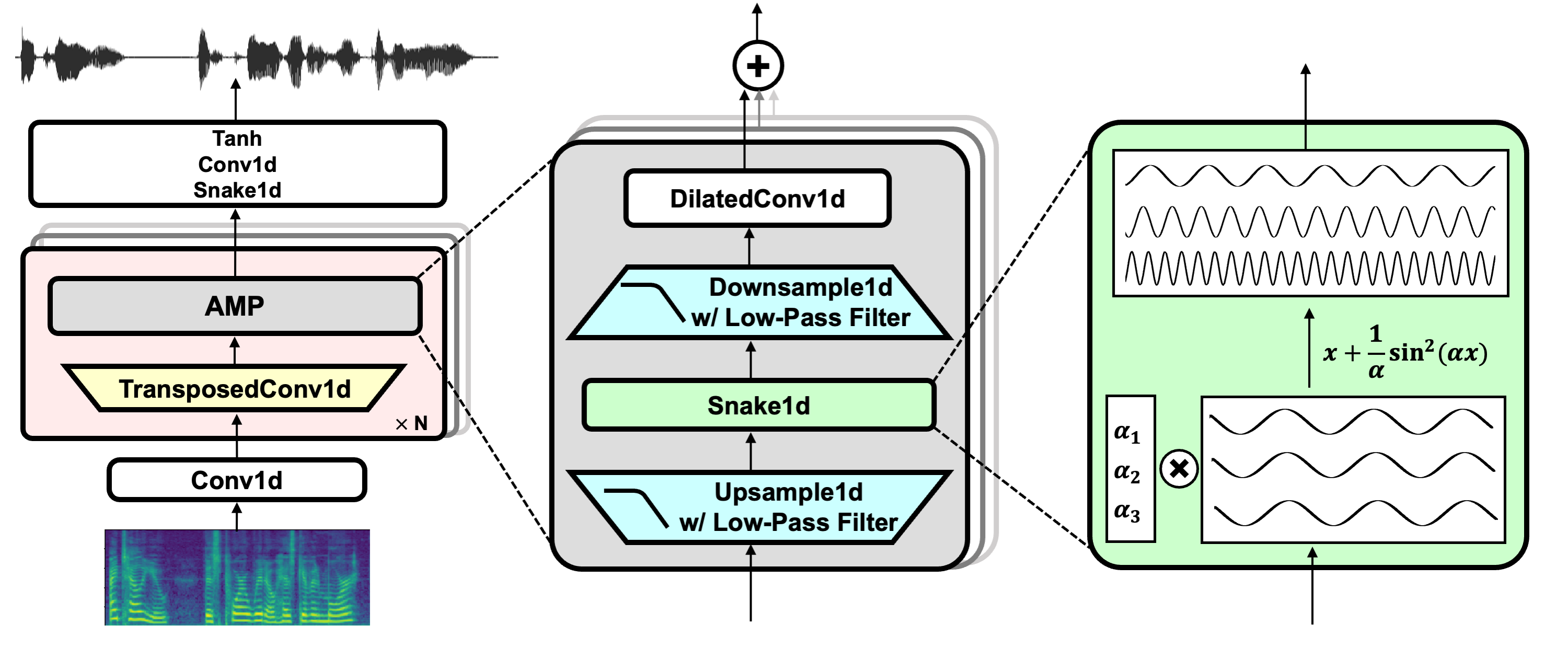🚀 BigVGAN: A Universal Neural Vocoder with Large-Scale Training
BigVGAN is a universal neural vocoder that enables high-quality audio generation through large-scale training.
Sang-gil Lee, Wei Ping, Boris Ginsburg, Bryan Catanzaro, Sungroh Yoon
[Paper] - [Code] - [Showcase] - [Project Page] - [Weights] - [Demo]


🚀 Quick Start
This repository provides pretrained BigVGAN checkpoints, allowing for easy inference and additional huggingface_hub support. If you're interested in model training and other features, visit the official GitHub repository: https://github.com/NVIDIA/BigVGAN.
✨ Features
News
- Jul 2024 (v2.3):
- General refactoring and code improvements for better readability.
- A fully fused CUDA kernel for anti-aliased activation (upsampling + activation + downsampling) with an inference speed benchmark.
- Jul 2024 (v2.2): The repository now includes an interactive local demo using Gradio.
- Jul 2024 (v2.1): BigVGAN is now integrated with 🤗 Hugging Face Hub, enabling easy inference with pretrained checkpoints. An interactive demo is also available on Hugging Face Spaces.
- Jul 2024 (v2): We released BigVGAN-v2 along with pretrained checkpoints. Highlights include:
- A custom CUDA kernel for inference: A fused upsampling + activation kernel written in CUDA for accelerated inference speed. Tests show 1.5 - 3x faster speed on a single A100 GPU.
- An improved discriminator and loss: BigVGAN-v2 is trained using a multi-scale sub-band CQT discriminator and a multi-scale mel spectrogram loss.
- Larger training data: BigVGAN-v2 is trained on datasets with diverse audio types, including multi-language speech, environmental sounds, and instruments.
- We offer pretrained checkpoints of BigVGAN-v2 with diverse audio configurations, supporting up to 44 kHz sampling rate and 512x upsampling ratio.
📦 Installation
git lfs install
git clone https://huggingface.co/nvidia/bigvgan_v2_22khz_80band_256x
💻 Usage Examples
Basic Usage
The following example demonstrates how to use BigVGAN: load the pretrained BigVGAN generator from Hugging Face Hub, compute the mel spectrogram from the input waveform, and generate a synthesized waveform using the mel spectrogram as the model input.
device = 'cuda'
import torch
import bigvgan
import librosa
from meldataset import get_mel_spectrogram
model = bigvgan.BigVGAN.from_pretrained('nvidia/bigvgan_v2_22khz_80band_256x', use_cuda_kernel=False)
model.remove_weight_norm()
model = model.eval().to(device)
wav_path = '/path/to/your/audio.wav'
wav, sr = librosa.load(wav_path, sr=model.h.sampling_rate, mono=True)
wav = torch.FloatTensor(wav).unsqueeze(0)
mel = get_mel_spectrogram(wav, model.h).to(device)
with torch.inference_mode():
wav_gen = model(mel)
wav_gen_float = wav_gen.squeeze(0).cpu()
wav_gen_int16 = (wav_gen_float * 32767.0).numpy().astype('int16')
Advanced Usage
You can apply the fast CUDA inference kernel by using the parameter use_cuda_kernel when instantiating BigVGAN:
import bigvgan
model = bigvgan.BigVGAN.from_pretrained('nvidia/bigvgan_v2_22khz_80band_256x', use_cuda_kernel=True)
When applied for the first time, it builds the kernel using nvcc and ninja. If the build succeeds, the kernel is saved to alias_free_activation/cuda/build and the model automatically loads the kernel. The codebase has been tested using CUDA 12.1.
Please ensure that both are installed in your system and that the nvcc version in your system matches the version used by your PyTorch build.
For more details, see the official GitHub repository: https://github.com/NVIDIA/BigVGAN?tab=readme-ov-file#using-custom-cuda-kernel-for-synthesis
📚 Documentation
Pretrained Models
We offer pretrained models on Hugging Face Collections. You can download the generator weight checkpoints (named bigvgan_generator.pt) and their discriminator/optimizer states (named bigvgan_discriminator_optimizer.pt) from the listed model repositories.
📄 License
This project is licensed under the MIT License.


 Transformers
Transformers